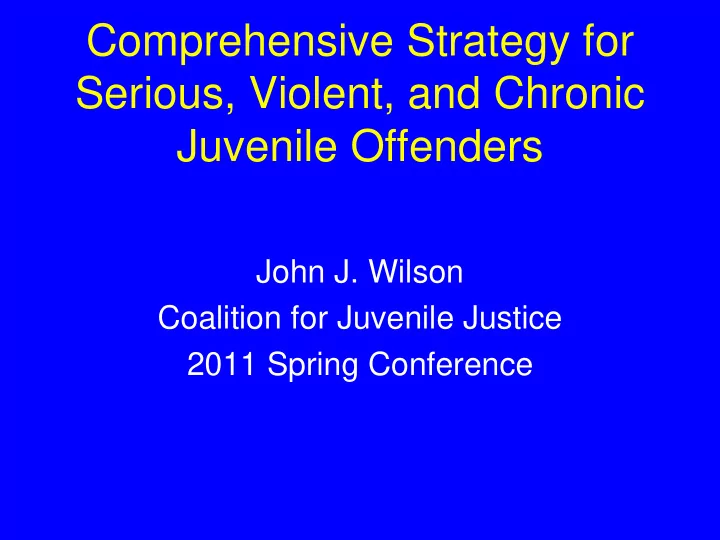

Comprehensive Strategy for Serious, Violent, and Chronic Juvenile Offenders John J. Wilson Coalition for Juvenile Justice 2011 Spring Conference
The Need For a Comprehensive Strategy • Poor targeting of serious, violent & chronic offenders • Little use of risk and needs assessments • Over-use of detention and incarceration • Use of ineffective programs • Reduced juvenile justice budgets
Comprehensive Strategy for Serious, Violent, and Chronic Juvenile Offenders Problem Behavior > Noncriminal Misbehavior > Delinquency > Serious, Violent, and Chronic Offending Prevention Graduated Sanctions Target Population: At-Risk Youth Target Population: Delinquent Youth Programs for Programs for Youth at I mmediate I ntermediate Community Training > > > > > > Aftercare All Youth Greatest Risk I ntervention Sanctions Confinement Schools Preventing youth from becoming Improving the juvenile justice system delinquent by focusing prevention response to delinquent offenders programs on at-risk youth through a system of graduated sanctions and a continuum of treatment alternatives Source: Wilson & Howell, 1993
The Comprehensive Strategy Continuum It is structured around six levels of parallel program interventions and sanctions, moving from least to most restrictive :
The Comprehensive Strategy Continuum, cont’d • Intervention programs tailored to identified risk and need factors, if appropriate, for first-time minor delinquent offenders provided under minimal sanctions • Intervention programs tailored to identified risk and need factors for nonserious repeat offenders and moderately serious first-time offenders provided under intermediate sanctions
The Comprehensive Strategy Continuum, cont’d • Intensive intervention programs tailored to identified risk and need factors for first-time serious or violent offenders provided under stringent sanctions • Multicomponent intensive intervention programs in secure correctional facilities for the most serious, violent, and chronic offenders
The Comprehensive Strategy Continuum, cont’d • Post-release supervision and transitional aftercare programs for offenders released from residential and correctional facilities.
Comprehensive Strategy Mantra Research- based Outcome- Data- focused driven
Key Principles of the Comprehensive Strategy We must (a) strengthen the family in its primary responsibility to instill moral values and provide guidance and support to children; (b) support “core” social institutions, schools, religious institutions, and community organizations in their roles of developing capable, mature, and responsible youth;
Key principles, cont’d (c) promote delinquency prevention as the most cost-effective approach to reducing juvenile delinquency; and (d) intervene immediately and effectively when delinquent behavior occurs.
Accountability • Graduated sanctions are often overused to promote “accountability,” a euphemism for punishment. A popular form is “zero tolerance” which, without services, is not likely to reduce delinquency and could have the opposite effect. • Shock incarceration, such “scared straight,” boot camps and other deterrence strategies may actually increase recidivism. • Punitive detention may wipe out the positive effects of treatment programs.
Accountability, cont’d. Sanctions provide only the context for service delivery; it is the therapeutic service within the setting that has the actual power to produce change in offenders. This is because services reduce risk & increase protective factors in the developmental domains: family, school, peer group, individual, and community.
Accountability, cont’d. Sanctions provide only the context for service delivery; it is the therapeutic service within the setting that has the actual power to produce change in offenders. This is because services reduce risk & increase protective factors in the developmental domains: family, school, peer group, individual, and community.
The Scope of the Delinquency Problem Because only a small fraction of adjudicated youths are serious, violent, and chronic offenders (see next slide), the delinquency problem is quite manageable using the Comprehensive Strategy framework and tools.
Juvenile Offender Court Careers Chronic Serious 15% 34% Non-Serious 64% Non-Violent C,S & V Non-Chronic 4% Violent 8% Source: Snyder (1998) Maricopa Co. Study (N= 151,209)
The Prevention Component •Use of a research-based risk and protection framework within the public health model helps structure the delinquency prevention enterprise in communities. •Prevention programs oriented toward reducing risk and enhancing protective factors can have beneficial effects for ameliorating a range of adverse outcomes.
Prevention and Intervention Windows of Opportunity Risk and Protective Factors Peer Individual Family Community School Group Characteristics Age 6 Age 15 Age 3 Age 9 Age 12 Age 18 Serious and Elementary Child Conduct Gang Violent School Delinquency Problems Member Delinquency Failure Treatment Prevention Early Intervention & Sanctions Source: Howell (2003)
Risk Factors for Delinquency •Family •School •Peers •Community •Individual
The Graduated Sanctions Component The graduated sanctions component of the Comprehensive Strategy consists of the last four levels of the overall framework in which treatment programs are combined with levels of supervision or control appropriate to the nature of juveniles’ offenses and their risk for reoffending.
A Graduated Sanctions Model Residential Placement Increasing Sanctions Decreasing Sanctions CB Resid. Intensive PS Day/Eve Intensive PS Report. Probation Probation Youth Court Group Counseling Mentoring Diversion
Structured Decision Making Tools � Detention screening instruments � Intake screening instruments � Research-based risk assessments � Objective assessments of youth and family strengths and needs � A placement matrix for recommending court dispositions � Standardized case plans � Routine monitoring and assessment of case plan implementation
Benefits of Using the Comprehensive Strategy • Increased prevention of delinquency • Enhanced responsiveness from the juvenile justice system • Greater accountability on the part of youth • Decreased costs of juvenile corrections • A more responsible juvenile justice system
Comprehensive Strategy Mantra • The right service for the right kid at the right time
Recommend
More recommend